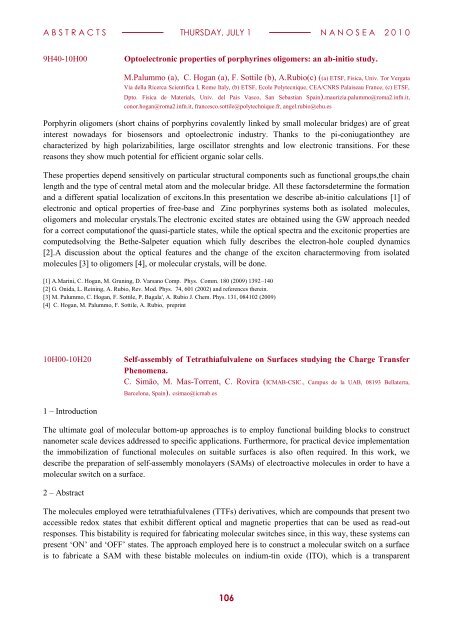book of abstracts - IM2NP
book of abstracts - IM2NP
book of abstracts - IM2NP
Create successful ePaper yourself
Turn your PDF publications into a flip-book with our unique Google optimized e-Paper software.
A B S T R A C T S THURSDAY, JULY 1 N A N O S E A 2 0 1 0<br />
9H40-10H00<br />
Optoelectronic properties <strong>of</strong> porphyrines oligomers: an ab-initio study.<br />
M.Palummo (a), C. Hogan (a), F. Sottile (b), A.Rubio(c) ((a) ETSF, Fisica, Univ. Tor Vergata<br />
Via della Ricerca Scientifica I, Rome Italy, (b) ETSF, Ecole Polytecnique, CEA/CNRS Palaiseau France, (c) ETSF,<br />
Dpto. Fisica de Materials, Univ. del Pais Vasco, San Sebastian Spain).maurizia.palummo@roma2.infn.it,<br />
conor.hogan@roma2.infn.it, francesco.sottile@polytechnique.fr, angel.rubio@ehu.es<br />
Porphyrin oligomers (short chains <strong>of</strong> porphyrins covalently linked by small molecular bridges) are <strong>of</strong> great<br />
interest nowadays for biosensors and optoelectronic industry. Thanks to the pi-coniugationthey are<br />
characterized by high polarizabilities, large oscillator strenghts and low electronic transitions. For these<br />
reasons they show much potential for efficient organic solar cells.<br />
These properties depend sensitively on particular structural components such as functional groups,the chain<br />
length and the type <strong>of</strong> central metal atom and the molecular bridge. All these factorsdetermine the formation<br />
and a different spatial localization <strong>of</strong> excitons.In this presentation we describe ab-initio calculations [1] <strong>of</strong><br />
electronic and optical properties <strong>of</strong> free-base and Zinc porphyrines systems both as isolated molecules,<br />
oligomers and molecular crystals.The electronic excited states are obtained using the GW approach needed<br />
for a correct computation<strong>of</strong> the quasi-particle states, while the optical spectra and the excitonic properties are<br />
computedsolving the Bethe-Salpeter equation which fully describes the electron-hole coupled dynamics<br />
[2].A discussion about the optical features and the change <strong>of</strong> the exciton charactermoving from isolated<br />
molecules [3] to oligomers [4], or molecular crystals, will be done.<br />
[1] A.Marini, C. Hogan, M. Gruning, D. Varsano Comp. Phys. Comm. 180 (2009) 1392–140<br />
[2] G. Onida, L. Reining, A. Rubio, Rev. Mod. Phys. 74, 601 (2002) and references therein.<br />
[3] M. Palummo, C. Hogan, F. Sottile, P. Bagala', A. Rubio J. Chem. Phys. 131, 084102 (2009)<br />
[4] C. Hogan, M. Palummo, F. Sottile, A. Rubio, preprint<br />
10H00-10H20<br />
Self-assembly <strong>of</strong> Tetrathiafulvalene on Surfaces studying the Charge Transfer<br />
Phenomena.<br />
C. Simäo, M. Mas-Torrent, C. Rovira (ICMAB-CSIC., Campus de la UAB, 08193 Bellaterra,<br />
Barcelona, Spain). csimao@icmab.es<br />
1 – Introduction<br />
The ultimate goal <strong>of</strong> molecular bottom-up approaches is to employ functional building blocks to construct<br />
nanometer scale devices addressed to specific applications. Furthermore, for practical device implementation<br />
the immobilization <strong>of</strong> functional molecules on suitable surfaces is also <strong>of</strong>ten required. In this work, we<br />
describe the preparation <strong>of</strong> self-assembly monolayers (SAMs) <strong>of</strong> electroactive molecules in order to have a<br />
molecular switch on a surface.<br />
2 – Abstract<br />
The molecules employed were tetrathiafulvalenes (TTFs) derivatives, which are compounds that present two<br />
accessible redox states that exhibit different optical and magnetic properties that can be used as read-out<br />
responses. This bistability is required for fabricating molecular switches since, in this way, these systems can<br />
present „ON‟ and „OFF‟ states. The approach employed here is to construct a molecular switch on a surface<br />
is to fabricate a SAM with these bistable molecules on indium-tin oxide (ITO), which is a transparent<br />
106

















